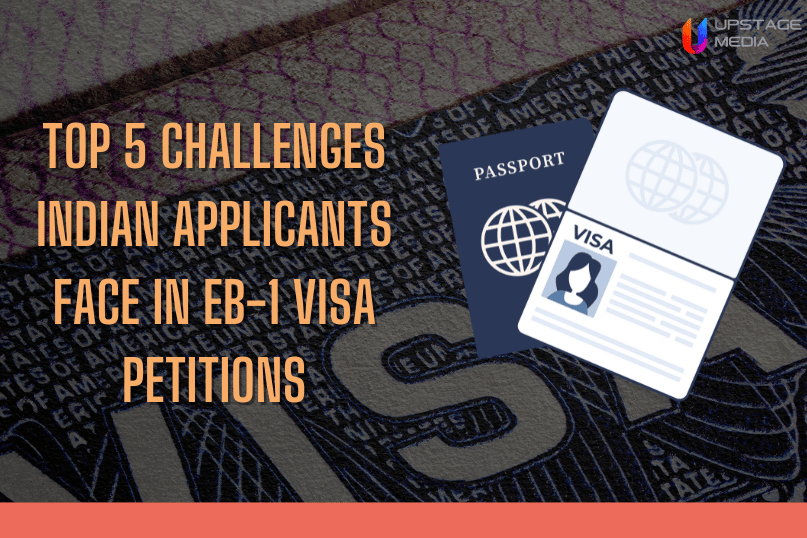Table of Contents
The EB-1 visa category is much-after-sought permanent residency option in the US. Only outstanding artists, scientists, educators, entrepreneurs, and sportsmen qualify. Indian workers who excel in several fields might gain permanent residence using an EB-1 visa. EB-1 visas are complex and difficult to obtain. This post discusses the five main challenges that an EB-1 visa applicant from India faces.
The high evidential requirements for outstanding potential are hard to meet. Applicants must provide a lot of evidence of their highest distinctions and achievements. Since it is subjective, “extraordinary ability” is tough to know whether what has been achieved meets the stringent standard of the U.S. immigration officials.
Challenge 1: Proving Extraordinary Ability

This makes EB-1A selective because only talented people are admitted into this category. The requirements expected of an applicant with regard to special ability are high. USCIS requires strong evidence and convincing proof from the applicant. Indian laborers have multiple skills but may fall short of meeting the requirements that the USCIS has in store.
EB-1A is hard to prove one’s own achievements because of the strict rules. This category required applicants to show their skills to the USCIS through awards, writing, and professional achievements. These variables are subjective, and real-world performance may differ from visa application standards.
These achievements may not be examined at all by the USCIS. There could be Indian professionals whose achievements are known in their country but not recognized by the criteria that are used for U.S. immigration. This gap may make visa applications difficult.
Challenge 2: Navigating Complex Documentation Requirements

Such a heavy amount of documentation may be required in support of EB-1 Visa Petitions. Method requires thorough preparation and presentation of material to support claims of exceptional ability or outstanding achievement. Applicants are expected to create a complete portfolio of all their achievements, honors, publications, and other documents in satisfaction of the high standards from USCIS.
Documents are complicated by the formatting and proof requirements of USCIS, with each document matching these standards taking time and effort. Many complications occur with papers, norms, and legal complications.
The application process is very complex and needs experts’ advice. Professional immigration attorneys or consultants can put together information in the best light to match the requirements and proffer the best chance of success for a petition. The candidates find the expertise of professionals easier for applying for an EB-1 visa.
Challenge 3: Overcoming cultural differences in achievements
Victories may be celebrated differently in India and in the US. The Indian problems in acquiring EB-1s are common. For example, nothing special in India may be appreciated by the U.S. visa system. The difference is what perhaps has been making it hard for Indian professionals to communicate globally.
Indian applicants may not be conversant with the facts and background required to place their successes before the U.S. courts. Awards and accomplishments considered very prestigious and respected in India could be less known or valued in the U.S., which may change the way that such achievements are assessed.
To resolve this, applicants must state their achievements in a way that is globally as well as U.S.-compliant. They knew of global impact and significance. In the same regard, U.S. judges will understand and have respect for the work. Convincing EB-1 immigration applications closes this gap.
Challenge 4: Facing Increased Scrutiny and RFEs
RFEs skyrocketed because of increased EB-1 visa scrutiny. USCIS RFEs request the applicant to provide more evidence to support the candidate’s case. Recent trends show stricter application screening, especially with competitive visas like the EB-1.
After an RFE, applicants are required to provide more documentation to fulfill the requirements laid down by the USCIS. This may be a very time-consuming and annoying process while you procure new documents and check whether they are according to the USCIS format. An RFE requires prompt and cautious data gathering and submission procedures; the time for applicants’ responses is limited. A proper PR to get your EB1 visa can be helpful in this case.
You will have to focus on the facts and the proof for being able to do this operation. This includes reevaluating the supplied papers, collecting further letters of recommendation, or even showing the applicant’s exceptional abilities or achievements. Managing RFEs is very disagreeable, and it postpones visa applications, making the case worse in settlement.
Most of the people seek the help of immigration lawyers or professionals so as to get through the process of RFE response. This aids in resolving USCIS problems and also strengthens your case.
Challenge 5: Dealing with Longer Processing Times

The Indian EB-1 visa applicant has to wait longer than others. The prime cause behind this is the stunningly long visa backlog in this category. Applicants are getting frustrated and baffled over coping with a long wait period.
There are many problems with the applicants due to long wait periods. Because it takes a long time to issue the visas, professionals may miss their opportunities or live in the same position. There could also be effects on family life as relocation and long-term planning become less sure. Since this wait period is combined with excess stress and a feeling of loss of control, it may be quite bad for the health of the candidate.
Applicants can, however, reduce these delays in a number of ways. Where possible, apply with a status change. This will fasten the process and decrease the waiting time. Applicants can also maintain constant communication with an immigration attorney. A good attorney will be able to counsel clients, update them on changes in working time, and help clients find solutions to issues related to waiting time.
These strategies, together with the expert guidance, can help applicants from India cope with extended wait periods and achieve immigration objectives with much greater confidence.
Conclusion
An Indian highly skilled worker can enter permanent residence in the US under an EB-1 visa. They are international experts known in the whole world. The application process does, however, have flaws that would make that journey to the United States of America quite a risk.
Applications need to showcase exceptional skill with huge amounts of paperwork and complex U.S. visa requirements. Monitoring may further complicate this process with RFEs, longer periods of work, and differences in acceptability between India and the U.S.
Such concerns must be taken into account by EB-1 candidates. These applications are not easy, so one has to be prepared and often needs help. Experienced immigration attorneys or counselors may assist applicants in framing the arguments and working through much of the associated stress and issues of the process.
The dangers, if known, and expert guidance can make a difference in Indian professionals succeeding with an EB-1 visa. This proactive approach maximizes the chances of approval, minimizes the problems, and makes permanent residency easier.
